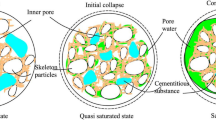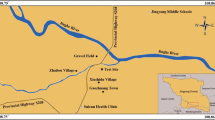Abstract
The deterioration of loess collapsibility under drying–wetting cycles is one of the serious threats to the artificial loess slopes and foundations in China, especially when soluble salt is involved. In this paper, a series of collapsibility tests were used to study the collapsibility deterioration of compacted loess with sodium sulfate under drying–wetting cycles, and the scanning electron microscope (SEM) tests were carried out to investigate the variation in microstructural properties. The results show gradual increase in the collapsibility of the loess samples with the increasing drying–wetting cycles and salt content. The collapsibility coefficient increases and gradually tends to stabilize with the progress of drying–wetting cycles, while changes linearly or exponentially with the salt content. The coupling effect of drying–wetting and salt erosion makes the loess skeleton looser and weaker in structure, providing more pore space for the deterioration of collapsibility, and when the salt content is greater than 0.5%, the deterioration ratio due to salt erosion is higher than that of drying–wetting. By fitting the collapsibility deterioration data with the hyperbolic function, the effect of drying–wetting cycles and salt content on the maximum and development speed of deterioration rate are quantitatively analyzed, and then, an interpolation equation of collapsibility deterioration considering both the influencing factors is established, which can well evaluate the collapsibility deterioration of compacted loess.

















Similar content being viewed by others
References
Chou Y, Wang L (2021) Soil-water characteristic curve and permeability coefficient prediction model for unsaturated loess considering freeze-thaw and dry-wet. Soils Rocks 44:1–11. https://doi.org/10.28927/SR.2021.058320
Fan X, Xu Q, Scaringia G, Li S, Peng D (2017) A chemo-mechanical insight into the failure mechanism of frequently occurred landslides in the Loess Plateau, Gansu Province, China. Eng Geol 228:337–345. https://doi.org/10.1016/j.enggeo.2017.09.003
Feng S-J, Du F-L, Shi Z-M, Shui W-H, Tan K (2015) Field study on the reinforcement of collapsible loess using dynamic compaction. Eng Geol 185:105–115. https://doi.org/10.1016/j.enggeo.2014.12.006
Higuchi K, Chigira M, Lee D-H, Wu J-H (2015) Rapid weathering and erosion of mudstone induced by saltwater migration near a slope surface. J Hydrol Eng. https://doi.org/10.1061/(ASCE)HE.1943-5584.0001105
Hu M, Liu Y, Ren J, Wu R, Zhang Y (2019) Laboratory test on crack development in mudstone under the action of dry-wet cycles. Bull Eng Geol Env 78:543–556. https://doi.org/10.1007/s10064-017-1080-x
Hu C, Yuan Y, Mei Y, Wang X, Liu Z (2020) Comprehensive strength deterioration model of compacted loess exposed to drying–wetting cycles. Bull Eng Geol Env 79:383–398. https://doi.org/10.1007/s10064-019-01561-8
Ietto F, Perri F, Cella F (2018) Weathering characterization for landslides modeling in granitoid rock masses of the Capo Vaticano promontory (Calabria, Italy). Landslides 15:43–62. https://doi.org/10.1007/s10346-017-0860-5
Jin Z, Guo L, Wang Y, Yu Y (2019) Valley reshaping and damming induce water table rise and soil salinization on the Chinese Loess Plateau. Geoderma 339:115–125. https://doi.org/10.1016/j.geoderma.2018.12.048
Kim D, Kang S-S (2013) Engineering properties of compacted loesses as construction materials. KSCE J Civ Eng 17:335–341. https://doi.org/10.1007/s12205-013-0872-1
Kong L, Sayem HM, Tian H (2017) Influence of drying–wetting cycles on soil-water characteristic curve of undisturbed granite residual soils and microstructure mechanism by nuclear magnetic resonance (NMR) spin-spin relaxation time (T2) relaxometry. Can Geotech J 55:208–216. https://doi.org/10.1139/cgj-2016-0614
Kong F, Nie L, Xu Y, Rui X, He Y, Zhang T, Wang Y, Du C, Bao C (2022) Effects of freeze-thaw cycles on the erodibility and microstructure of soda-saline loessal soil in Northeastern China. CATENA 209:105812. https://doi.org/10.1016/j.catena.2021.105812
Lei X (1987) The types of loess pores in China and their relationship with collapsibility. Sci China B 17:1309–1318
Li G, Ma W, Zhao S, Mao Y, Mu Y (2012) Effect of freeze-thaw cycles on mechanical behavior of compacted fine-grained soil. Cold Reg Eng 2012:72–81
Li P, Vanapalli S, Li T (2016) Review of collapse triggering mechanism of collapsible soils due to wetting. J Rock Mech Geotech Eng 8:256–274. https://doi.org/10.1016/j.jrmge.2015.12.002
Li G, Wang F, Ma W (2018) Variations in strength and deformation of compacted loess exposed to wetting-drying and freeze-thaw cycles. Cold Reg Sci Technol 151:159–167. https://doi.org/10.1016/j.coldregions.2018.03.021
Li X-A, Li L, Song Y, Hong B, Wang L, Sun J (2019) Characterization of the mechanisms underlying loess collapsibility for land-creation project in Shaanxi Province, China-a study from a micro perspective. Eng Geol 249:77–88. https://doi.org/10.1016/j.enggeo.2018.12.024
Liu C, Shi B, Zhou J, Tang C (2011) Quantification and characterization of microporosity by image processing, geometric measurement and statistical methods: application on SEM images of clay materials. Appl Clay Sci 54:97–106. https://doi.org/10.1016/j.clay.2011.07.022
Liu W, Tang X, Yang Q, Li W (2015) Influence of drying/wetting cycles on the mechanical cyclic behaviours of silty clay. Eur J Environ Civ Eng 19:867–883. https://doi.org/10.1080/19648189.2014.974833
Lu H, Li J, Wang W, Wang C (2015) Cracking and water seepage of Xiashu loess used as landfill cover under wetting–drying cycles. Environ Earth Sci 74:7441–7450. https://doi.org/10.1007/s12665-015-4729-4
Luo H, Wu F, Chang J, Xu J (2017) Microstructural constraints on geotechnical properties of Malan Loess: a case study from Zhaojiaan landslide in Shaanxi province, China. Eng Geol 236:60–69. https://doi.org/10.1016/j.enggeo.2017.11.002
Malusis MA, Yeom S, Evans JC (2011) Hydraulic conductivity of model soil–bentonite backfills subjected to wet–dry cycling. Can Geotech J 48:1198–1211. https://doi.org/10.1139/t11-028
Md SH, Ling-wei K, Song Y (2016) Effect of drying–wetting cycles on saturated shear strength of undisturbed residual soils. Am J Civ Eng 4:143–150. https://doi.org/10.11648/j.ajce.20160404.15
Mohurd P (2019) Standard for geotechnical testing method GB/T 50123-2019. China Planning Press, Beijing (In Chinese)
Ni W, Yuan K, Lv X, Yuan Z (2020) Comparison and quantitative analysis of microstructure parameters between original loess and remoulded loess under different wetting-drying cycles. Sci Rep. https://doi.org/10.1038/s41598-020-62571-1
Peng S, Wang F, Fan L (2019) Experimental study on influence of vaporous water on salt expansion of sulfate saline soil. Adv Civ Eng. https://doi.org/10.1155/2019/6819460
Pires FL, Auler CA, Roque LW, Mooney JS (2020) X-ray microtomography analysis of soil pore structure dynamics under wetting and drying cycles. Geoderma 362:114103. https://doi.org/10.1016/j.geoderma.2019.114103
Scelsi G, Abed AA, Della Vecchia G, Musso G, Solowski WT (2021) Modelling the behaviour of unsaturated non-active clays in saline environment. Eng Geol. https://doi.org/10.1016/j.enggeo.2021.106441
Shao X, Zhang H, Tan Y (2018) Collapse behavior and microstructural alteration of remolded loess under graded wetting tests. Eng Geol 233:11–22. https://doi.org/10.1016/j.enggeo.2017.11.025
Shen Y, Chen W, Kuang J, Du W (2017) Effect of salts on earthen materials deterioration after humidity cycling. J Central South Univ 24:796–806. https://doi.org/10.1007/s11771-017-3482-0
Soulié F, Cherblanc F, Youssoufi MSE, Saix C (2006) Influence of liquid bridges on the mechanical behaviour of polydisperse granular materials. Int J Numer Anal Meth Geomech 30:213–228. https://doi.org/10.1002/nag.476
Tang C, Shi B, Liu C, Zhao L, Wang B (2008) Influencing factors of geometrical structure of surface shrinkage cracks in clayey soils. Eng Geol 101:204–217. https://doi.org/10.1016/j.enggeo.2008.05.005
Tripathy S, Rao KSS (2009) Cyclic swell-shrink behaviour of a compacted expansive soil. Geotech Geol Eng 27:89–103. https://doi.org/10.1007/s10706-008-9214-3
Wang HB, Zhou B, Wu SR, Shi JS (2011) Characteristic analysis of large-scale loess landslides: a case study in Baoji City of Loess Plateau of Northwest China. Nat Hazard 11:1829–1837. https://doi.org/10.5194/nhess-11-1829-2011
Wang L, Shao S, She F (2019a) A new method for evaluating loess collapsibility and its application. Eng Geol 264:105376. https://doi.org/10.1016/j.enggeo.2019.105376
Wang Z, Fan B, Guo L (2019b) Soil salinization after long-term mulched drip irrigation poses a potential risk to agricultural sustainability: Soil salinization under mulched drip irrigation. Eur J Soil Sci 70:20–24. https://doi.org/10.1111/ejss.12742
Wang F, Li G, Ma W, Mu Y (2020) Effect of repeated wetting-drying-freezing-thawing cycles on the mechanic properties and pore characteristics of compacted loess. Adv Civ Eng 2020:1–8. https://doi.org/10.1155/2020/8839347
Wang H, Ni W, Liu H, Huang M, Yuan K, Li L, Li X (2021a) Study of the repeated collapsibility of undisturbed loess in Guyuan, China. Bull Eng Geol Environ. https://doi.org/10.1007/s10064-021-02304-4
Wang H, Ni W, Yuan K, Li L (2021b) Microstructure evolution of loess under multiple collapsibility based on nuclear magnetic resonance and scanning electron microscopy. J Mt Sci. https://doi.org/10.1007/s11629-021-6838-8
Xu L, Coop M (2016) Influence of structure on the behavior of a saturated clayey loess. Can Geotech J 53:1026–1037. https://doi.org/10.1139/cgj-2015-0200
Xu X, Wang Y, Bai R, Zhang H, Hu K (2016) Effects of sodium sulfate content on mechanical behavior of frozen silty sand considering concentration of saline solution. Res Phys 6:1000–1007. https://doi.org/10.1016/j.rinp.2016.11.040
Xu P, Zhang Q, Qian H, Qu W (2020) Effect of sodium chloride concentration on saturated permeability of remolded loess. Minerals. https://doi.org/10.3390/min10020199
Xu P, Zhang Q, Qian H, Qu W, Li M (2021) Microstructure and permeability evolution of remolded loess with different dry densities under saturated seepage. Eng Geol. https://doi.org/10.1016/j.enggeo.2020.105875
Xue C, Wang X, Liu K (2020) Effect of soaking time and salt concentration on mechanical characteristics of slip zone soil of loess landslides. Water 12:3465. https://doi.org/10.3390/w12123465
Yan C, An N, Wang Y, Sun W (2021) Effect of dry-wet cycles and freeze-thaw cycles on the antierosion ability of fiber-reinforced loess. Adv Mater Sci Eng 2021:8834598. https://doi.org/10.1155/2021/8834598
Yilmaz G, Yetimoglu T, Arasan S (2008) Hydraulic conductivity of compacted clay liners permeated with inorganic salt solutions. Waste Manage Res 26:464–473. https://doi.org/10.1177/0734242X08091586
Ying C, Hu X, Zhou C, Sumi S (2021) Analysis of chemo-mechanical behavior of silty soil under long-term immersion in saline reservoir water. Bull Eng Geol Env 80:627–640. https://doi.org/10.1007/s10064-020-01928-2
Zhang F, Wang G, Kamai T, Chen W (2013) Undrained shear behavior of loess saturated with different concentrations of sodium chloride solution. Eng Geol 155:69–79. https://doi.org/10.1016/j.enggeo.2012.12.018
Zhang Y, Hu Z, Xue Z (2018) A new method of assessing the collapse sensitivity of loess. Bull Eng Geol Env 77:1287–1298. https://doi.org/10.1007/s10064-018-1372-9
Zhang W, Ma J, Tang L (2019) Experimental study on shear strength characteristics of sulfate saline soil in Ningxia region under long-term freeze-thaw cycles. Cold Reg Sci Technol 160:48–57. https://doi.org/10.1016/j.coldregions.2019.01.008
Zhang Y, Hassan MA, King L, Fu X, Istanbulluoglu E, Wang G (2020) Morphometrics of China’s Loess Plateau: the spatial legacy of tectonics, climate, and loess deposition history. Geomorphology. https://doi.org/10.1016/j.geomorph.2020.107043
Acknowledgements
This work was supported by the Key Program of the National Natural Science Foundation of China (Grant no. 41931285), and the Key Research and Development Program of Shaanxi Province (Grant no. 2019ZDLSF05-07).
Funding
This work was funded by the Key Program of the National Natural Science Foundation of China (Grant no. 41931285), and the Key Research and Development Program of Shaanxi Province (Grant no. 2019ZDLSF05-07).
Author information
Authors and Affiliations
Corresponding author
Ethics declarations
Conflict of interest
The authors declare that they have no conflict of interest.
Additional information
Publisher's Note
Springer Nature remains neutral with regard to jurisdictional claims in published maps and institutional affiliations.
Rights and permissions
Springer Nature or its licensor holds exclusive rights to this article under a publishing agreement with the author(s) or other rightsholder(s); author self-archiving of the accepted manuscript version of this article is solely governed by the terms of such publishing agreement and applicable law.
About this article
Cite this article
Nie, Y., Ni, W., Tuo, W. et al. Collapsibility deterioration mechanism and evaluation of compacted loess with sodium sulfate under drying–wetting cycles. Nat Hazards 115, 971–991 (2023). https://doi.org/10.1007/s11069-022-05581-8
Received:
Accepted:
Published:
Issue Date:
DOI: https://doi.org/10.1007/s11069-022-05581-8




